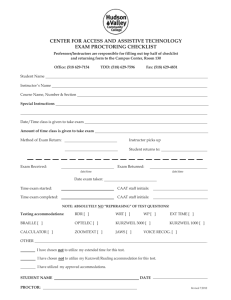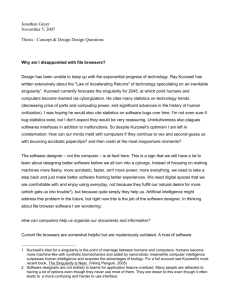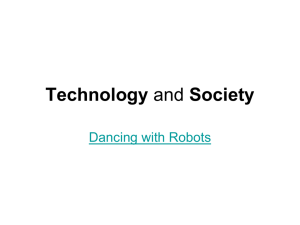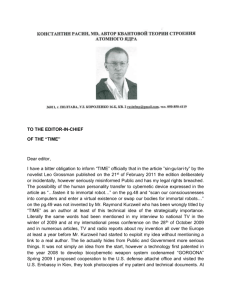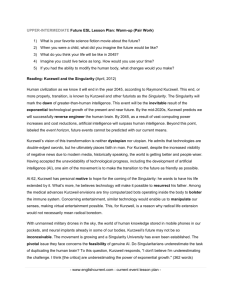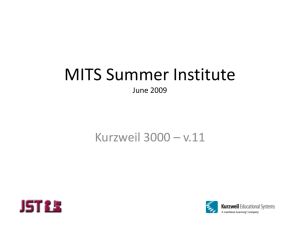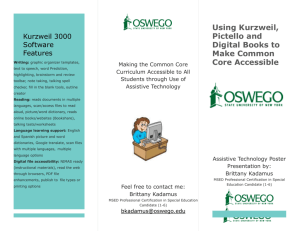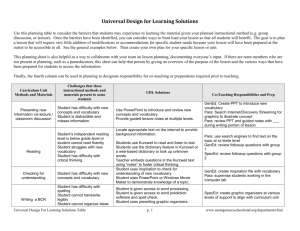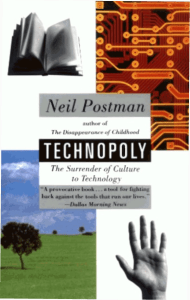Technopoly - University of Wisconsin
advertisement
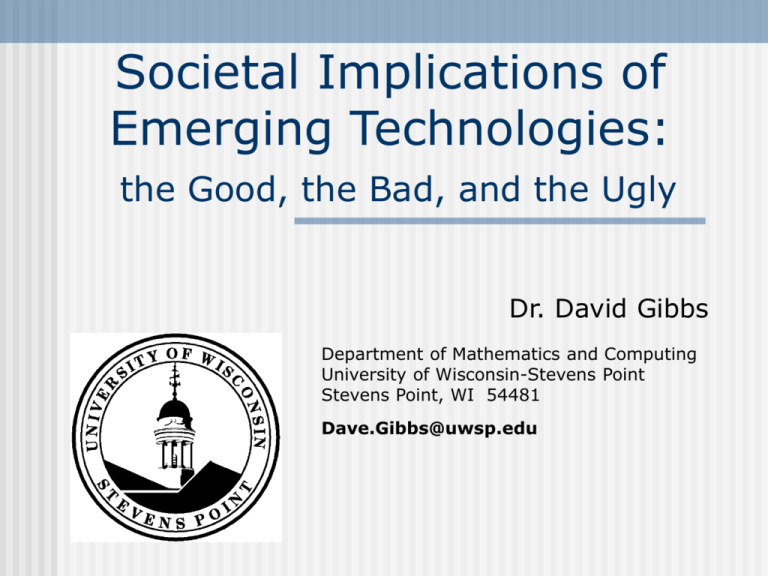
Societal Implications of Emerging Technologies: the Good, the Bad, and the Ugly Dr. David Gibbs Department of Mathematics and Computing University of Wisconsin-Stevens Point Stevens Point, WI 54481 Dave.Gibbs@uwsp.edu RMM Technology Fair Westwood Center Wausau, Wisconsin April 20, 2006 Why Am I Here? this UWSP course – CIS 300: America in the Age of Information Critical assessment of impact of information revolution on American society, including contemporary life, professions, privacy, security, education, law, government and employment. CIS 300 Course Components Readings 3 books Web readings Assorted hand-outs, including “anonymous” Student Presentations all “lectures” of the content e-News (current events in the Information Society) BYC – “Because You Can” technologies “Because You Can” (BYCs) Q: Why would they create that? A: Because they can… The LumiTouch Project MP3 Implants Neuticles Verichip (at right) CIS 300 Course Components Writing Emphasis Interim - 6 written papers in 12 days Activities Debate: National ID Cards • Including Biometric device discussions • Including DNA analysis as the ultimate identification scheme the authors Neil Postman, Technopoly: The Surrender of Culture to Technology Ray Kurzweil, The Age of Spiritual Machines: When Computers Exceed Human Intelligence Aldous Huxley, Brave New World Neil Postman 1931-2003 NYU Professor, media theorist, and cultural critic 18 books, 200+ articles Technopoly: The Surrender of Culture to Technology “Legend of Thamus” from Plato’s Phaedrus (dialog) King Thamus entertaining Theuth, the inventor of numbers, calculation, geometry, astronomy, and writing. Legend of Thamus Theuth, on his invention of writing: “Here is an accomplishment, my lord the king, which will improve both the wisdom and the memory of the Egyptians. I have discovered a sure receipt for memory and wisdom.” Legend of Thamus King Thamus, on Theus’ writing: “Theuth, my paragon of inventors, the discoverer of an art is not the best judge of the good or harm which will accrue to those who practice it. So it is in this; you, who are the father of writing, have out of fondness for your off-spring attributed to it quite the opposite of its real function. Those who acquire it will cease to exercise their memory and become forgetful; they will rely on writing to bring things to their remembrance by external signs instead of by their own internal resources.” Legend of Thamus King Thamus, on Theus’ writing continued: “What you have discovered is a receipt for recollection, not for memory. And as for wisdom, your pupils will have the reputation for it without the reality: they will receive a quantity of information without proper instruction, and in consequence be thought very knowledgeable when they are for the most part quite ignorant. And because they are filled with the conceit of wisdom instead of real wisdom they will be a burden to society.” Legend of Thamus Why does Postman begin his book with this story? Why do I begin this talk with it? Legend of Thamus Thamus was right – but only halfright. Writing is NOT just a burden – it is both – and at the same time – a burden and a blessing. CIS 300 Course Components First written assignment “Benefits and Harms of Technology” 6 technologies • 3 positive, or beneficial • 3 negative, or harmful Present (and defend) your choices in class • Examples: cell phones, tv, i-pods, nuclear power Technology is non-neutral ALL technologies bring blessings and burdens. CHALLENGE: find a technology that is either ALL good or ALL bad. With apologies to Clint Eastwood NOT the Good, the Bad, and the Ugly… BUT The Good AND Bad, and the Ugly Technopoly: The Surrender of Culture to Technology Taxonomy of Culture, a timeline Intersection of Tools/Technology and Culture 1. 2. 3. Tool-Using: rocks, fire, to 1776 Technocracy: 1770s to 1910 Technopoly: 1910 to present The Taxonomy: stage 1 A Tool-Using Culture Tools solved the immediate problems of physical life, or, • Water power, windmills, plow Serve the symbolic world of art, religion, politics • Cathedrals, castles The Taxonomy: stage 2 Technocracy A society loosely controlled by social custom and religious tradition Tools moving Europe from a tool-using culture to technocracy: • Clock • Printing press • Telescope Origins of the “scientific method” The Taxonomy: stage 2 Technocracy Began in late 1700s • 1765 James Watt, steam engine • 1776, as defined by Adam Smith in Wealth of Nations Communications “Revolution” began • Books (now affordable), telegraph, typewriter, transatlantic cable, photography Life just “sped up” The Taxonomy: stage 3 Technopoly The submission of all forms of cultural life to the sovereignty of technique and technology. Began in early 1900s • 1925 Scopes “monkey” trial • 1910 Frederick Taylor, Scientific Management – EFFICIENCY maxims The Principles of Scientific Management The goal of human labor and thought is efficiency Technical calculation is superior to human judgment Human judgment cannot be trusted (laziness, ambiguity, subjectivity) What cannot be measured either does not exist or is of no value Technopoly: The Surrender of Culture to Technology To summarize: Tool-using Technocracy Technology is integrated into the culture Technology attacks the culture Technopoly Technology becomes the culture; efficiency is the paramount goal Truisms If what you have is a hammer, everything looks like a nail. If what you have is a computer, everything looks like data. If what you know is the scientific method, everything is solvable by applying science or engineering. Gibbsian Truisms Technology serves to distance people. Warfare Communications What technology makes easy to do, we tend to do. Ray Kurzweil born 1948 Inventor, Author, Entrepreneur, Futurist Video Intro Kurzweil the Author The Age of Intelligent Machines (1989) The 10% Solution for a Healthy Life (1993) The Age of Spiritual Machines: When Computers Exceed Human Intelligence (2000) Fantastic Voyage: Live Long Enough to Live Forever (2004) The Singularity is Near: When Humans Transcend Biology (2005) Kurzweil the Entrepreneur Kurzweil AI.Net Kurzweil Computer Products Kurzweil Technologies Kurzweil Music Systems Kurzweil Applied Intelligence Kurzweil Educational Systems Kurzweil CyberArt Technologies FatKat Ray & Terry’s Longevity Products Kurzweil the Futurist Predictions from 1989 book / Reflections from the 2000 book P: Computer will defeat human in chess by 1998 R: IBM’s Deep Blue defeated Gary Kasparov in 1997 P: World-wide information network will emerge R: The Web emerged in 1994 and then took off P: Software-based technologies will dominate in warfare R: The (first) Gulf War established this paradigm P: Biometric identification will replace locks and keys R: Speech and facial pattern recognition used to control access Kurzweil the Futurist Predictions from 1989 book / Reflections from the 2000 book P: School classrooms will get “wired” R: Programs were in place in most states P: Most commercial music will be created on synthesizers R: TV, movies, recordings use synthesizers, sequencers, sound generators P: Continuous Speech Recognition with large vocabularies will emerge in the early 90s R: Available by 1996 Aldous Huxley 1894 – 1963 British Novelist/Essayist Brave New World (1932) Science Fiction: utopian (dystopian) picture of life in 2532 A.D. Brave New World Babies are “decanted” from jars after 267 days on assembly line Caste-like society: alphas to epsilons Conditioning from pre-birth throughout; books outlawed Promiscuity is required No family; “mother”, “father” are obscenities Soma Worship “Our Ford”; spirituality turned into sex orgies Consumption (consumerism) is preeminent Kurzweil before Congress Testimony (2003) “Size” of technology is shrinking Moral imperative to overcome human affliction Economic imperative, in a competitive economy Most of technology will be “nanotechnology” by 2020 “With the advent of nanotechnology, we will be able to keep our bodies and brains in a healthy, optimal state indefinitely.” (p. 3 of 45) Kurzweil: here’s why… Intuitive Linear View vs. Historical Exponential View Law of Accelerating Returns Human intelligence has limitations; machine intelligence does not Specific technological paradigms exhibit S-curve growth (e.g. Moore’s Law) S-curves Start slowly, accelerate rapidly, and taper off (until the next paradigm kicks in and the process begins anew) Linear vs Exponential 1200 1000 800 600 400 200 0 1 2 3 4 5 Linear 6 7 Exponential 8 9 10 What is meant by “doubly” exponential? It means exponential growth in the rate of growth, that is, in the exponent. Exp: 2^x Doubly 2^(2^x) Many information technologies exhibit this – as costs decrease, more resources are deployed (Singularity, p. 25) What will be the impact of Smaller, Faster, Convergence? Biotechnology Genetics Nanotechnology Robotics Biotechnology Genetically modified organisms (GMO) Transgenic plants, animals Can humans be far behind? (“designer genes”) Choose your offspring • (What technology makes easy to do we tend to do) • (Technology serves to distance people) Good? Bad? Ugly? Nanotechnology 1 nanometer (nm) = 10-9 (one-billionth of a meter) Water molecule: 0.3nm DNA chain: 2.5nm across Red blood cell: 7,000nm Typical human cell: 20,000nm Human hair: 80,000nm across Nanotechnology Combined with “robotics” (artificial intelligence) yields – “Nanobots” e.g. Foglets (as per Michael Crichton, Prey) • 100 micrometer = 100,000nm Deliver chemotherapy directly to a cancer cell Multitudinous medical uses Issues • Malicious use? • Self-replication? Nanobots Good? Much more than good! Bad? Maybe so! Ugly? Easy to paint an ugly picture! RFID Chips Radio-frequency-identification Components Chip (with unique ID#) Antenna Reader RFID chips (syn: tags, transponders) Passive Tags No internal power source Activated by a “reader” Active Tags Contain a battery, thus larger Used in electronic toll gathering (right), parking lots Parking Lot with RFID How does it work? EPC – electronic product code 96 bit code; i.e. 2^^96 or 7.92 x 1028 unique ids EPC and RFID How many things can be tagged with 1028 unique ids? Everything? People too? The “Internet of Things” Every tagged item could have its own web page! Early applications of RFID included automatic highway toll collection supply-chain management (for large retailers) pharmaceuticals (for the prevention of counterfeiting) e-health (for patient monitoring) RFID anywhere, everywhere More recent applications sports and leisure (ski passes) Tracking cattle (carcasses) personal security (tagging children at schools) Access to bars like the Baja Beach Club in Barcelona Military ID (dog-tags, etc.) Login to your computer! (at right) RFID E-government applications under consideration: RFID in drivers’ licenses passports Currency (prevent counterfeiting) RFID readers are now being embedded in mobile phones. Nokia, released RFID-enabled phones for businesses with workforces in the field in mid-2004 plans to launch consumer handsets in 2006. Retail Purchases? 1. 2. Put items in your cart Walk out! (provided you have an RFID yourself – embedded or otherwise) “And he causeth all, both small and great, rich and poor, free and bond, to receive a mark in their right hand, or in their foreheads. And that no man might buy or sell, save he that had the mark, or the name of the beast, or the number of his name.” Rev 13: 16-17 RFID Good? Bad? Market-supply management Big-brother, done to ourselves by ourselves (what computers make easy to do we tend to do) Ugly? What uses haven’t we even thought of? Kurzweil on “evolution” Evolution takes place at an exponential rate. Evolution is not just the process of organisms, but includes their “tools” (technologies) Technologies evolve, exponentially Evolution is ONE process, from single-cell to multi-cell to humans, to humans with technology, to human/technology sameness. Kurzweil: The History of Evolution “Evolution is a process of creating patterns of increasing order.” Epoch 1: Physics and Chemistry Epoch 2: Biology Epoch 3: Brains Epoch 4: Technology Epoch 5: Merger of Technology and Human Intelligence Epoch 6: The Universe Wakes Up (Singularity, pp. 14-15) Epoch 1: Physics and Chemistry Big Bang Physics Chemistry Information in atomic structures Epoch 2: Biology Carbon-based compounds became increasingly intricate Development of precise digital mechanism (DNA) to store results of the evolutionary experiments Information in DNA Epoch 3: Brains Begins as animals recognizing patterns Eventually creating abstract mental models Information in neural patterns Epoch 4: Technology Increasing brain size (protein sources?) and opposing thumbs result in the evolution of humancreated technology. Information in hardware and software designs Epoch 5: Merger of Technology and Human Intelligence This marks the beginning of the Singularity – in Kurzweil’s view, around 2040 Integration of biology (including human intelligence) with the exponentially expanding human technology base (i.e. computers) Epoch 6: The Universe Wakes Up Patterns of matter and energy in the universe become saturated with intelligent processes and knowledge HOW? By reorganizing matter and energy – focusing on the goal of spreading out from planet Earth Kurzweil: How to live forever? MUST REACH THE SINGULARITY! Fantastic Voyage website Reprogram your biochemistry Q&A “I take 250 supplements a day and really feel that I’m reprogramming my biochemistry, just like I would reprogram my computers.” “We advocate being active in reprogramming your biochemistry to achieve optimal health.” Three Bridges to Immortality Three Bridges to Immortality Bridge 1: Applying Today’s Knowledge Bridge 2: Biotechnology Re-program your biochemistry (NOW); “best” practices and lots of supplements Genetic tweaking, of both babies and baby boomers (within the NEXT decade) Bridge 3: NanoTechnology Nanobots in your bloodstream destroying pathogens, removing debris, correcting DNA errors, and reversing aging processes and then…. The Singularity is Here Human life is transformed Humans will transcend the limitations of biological bodies and brains Extend and expand “thinking” “By 2100, nonbiological intelligence will be trillions and trillions of times more powerful than unaided human intelligence.” (Singularity, p.9) In a post-Singularity world... “There will be no distinction, postSingularity, between human and machine or between physical and virtual reality.” (Singularity, p. 9) Summary Postman: Technopoly Huxley: BNW Machines and humans in tension Humans are (biological) machines Kurzweil: two techno-steps to the Singularity Biotech Nanotech No discernible difference between humans and machines What to do, what to do? Reverse the truisms – in your own life Stop “distancing” people – (HOW??) Don’t always do what technology makes easy to do – (DIFFICULT!!) Remember the “human”; what do you value? Remember the “sacred”; there’s a reason those belief systems have been around for millennia Thanks! http://www.uwsp.edu/cis/dgibbs/RMM Dave.Gibbs@uwsp.edu
